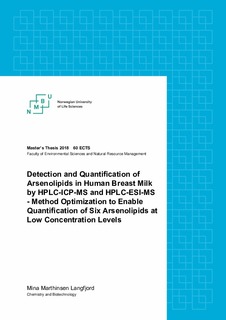| dc.contributor.advisor | Gjengedal, Elin | |
| dc.contributor.advisor | Fransesconi, Kevin A. | |
| dc.contributor.advisor | Eggesbø, Merete | |
| dc.contributor.author | Langfjord, Mina Marthinsen | |
| dc.date.accessioned | 2018-10-01T11:23:25Z | |
| dc.date.available | 2018-10-01T11:23:25Z | |
| dc.date.issued | 2018 | |
| dc.identifier.uri | http://hdl.handle.net/11250/2565484 | |
| dc.description.abstract | Recent research has shown that some arsenic containing lipids, common components of seafood, are highly cytotoxic and have the potential to cross the blood-brain barrier. Infants, in particular, are especially sensitive to exposure due to the critical stage of development of the brain and nervous system. Thus, the aim was to optimize a method to enable identification and quantification of arsenic containing lipids in 21 breast milk samples selected from the Norwegian Human Milk Study (HUMIS- NoMIC). Initial testing of 10 milk samples had shown that a significant proportion of the total arsenic occurred in lipid-soluble forms, and the major arsenolipids occurring in five of those samples were identified as arsenic hydrocarbons and arsenic fatty acids.
In the present work, the extraction solvent used, volumes used of sample material, solvents and reagents, and ruggedness in the sample purification procedure was tested in an attempt of optimizing the method before 21 additional breast milk samples were processed. By performing several spike recovery tests, it was confirmed that the intermediate precision was satisfactory. However, to obtain comparability and traceability it is essential to improve the reproducibility and find a way to obtain information about the accuracy.
The samples were analysed with high performance liquid chromatography coupled with a splitter to elemental and molecular mass spectrometers to determine both molecular structures and concentrations of the arsenolipids. The concentrations of arsenolipids in the human breast milk samples were low (<1.0 μg As/L), and fell below the limit of quantification (LOQ) in most of the samples. However, the presence of four out of six arsenolipids were confirmed. Additional method optimization is required to obtain reliable information on the concentrations of these compounds, by finding the conditions that provides quantitative measurements with an acceptable uncertainty at a sufficient low LOQ.
As a new approach to obtain recovery information, preparation of an arsenolipid internal standard by methylation of standard, purified milk samples, and raw milk samples were attempted. This approach showed some promising results with deuterium labelled methylated internal standards, but further work is essential to develop a reliable internal standard for the speciation of arsenic containing lipids. | nb_NO |
| dc.description.abstract | Nyere forskning har vist at noen arsenholdige lipider, som er naturlig forekommende forbindelser i fisk og sjømat, er svært cytotoksiske og kan potensielt krysse blod-hjerne barrieren. Spedbarn er spesielt sensitive for eksponering for disse forbindelsene da utvikling av hjerne og nervesystem er på et kritisk stadie så tidlig i livet. Målet med arbeidet var derfor å optimalisere en metode for å muliggjøre identifikasjon og kvantifikasjon av arsenolipider i 21 morsmelkprøver fra den norske morsmelkstudien, HUMIS-NoMIC. Et tidligere forsøk med 10 melkeprøver viste at en signifikant andel av total konsentrasjon av arsen er fettløselig, og ble identifisert som arsenholdige hydrokarboner og fettsyrer i fem av disse prøvene.
I dette arbeidet ble bruk av ekstraksjonsmiddel, volum benyttet for prøver, reagenser og løsninger, samt prøveprepareringens robusthet testet i et forsøk på å optimalisere den nyutviklede metoden. Ytterligere 21 melkeprøver ble behandlet og analysert. Som et valideringsverktøy ble flere spike-recovery forsøk gjennomført hvor presisjon mellom replikater var tilfredsstillende. For å oppnå sammenlignbarhet og sporbarhet, er det essensielt å forbedre reproduserbarheten og å finne en måte å bestemme nøyaktighet.
Prøvene ble analysert ved bruk av HPLC koblet med en splitter til både elementær og molekylær spektroskopi for bestemmelse av konsentrasjon og molekylær struktur av arsenolipidene. Konsentrasjonen av arsenolipidene i morsmelken var lave (<1,0 μg As/L) og falt under kvantifiseringsgrensen (LOQ) for de fleste arsenolipidene av interesse i de fleste prøvene. Tilstedeværelse av fire av seks arsenolipider ble likevel bekreftet. Videre optimalisering av metoden er nødvendig for å kunne oppnå pålitelig informasjon om arsenolipidenes konsentrasjoner, noe som lar seg gjøre ved å finne betingelser som gir kvantitative målinger med akseptabel usikkerhet ved en tilstrekkelig lav kvantifiseringsgrense.
Som en ny fremgangsmåte for å bestemme gjenfinning, ble det forsøkt å lage en internstandard for disse arsenolipidene ved å metylere syntetiserte standarder, renset melk og urenset melk. Forsøkene med deuterium merkede, metylerte internstandarder var lovende, men videre arbeid er essensielt for å utvikle en pålitelig internstandard for bruk i forsøk som omhandler spesiering av arsenholdige lipider. | nb_NO |
| dc.language.iso | eng | nb_NO |
| dc.publisher | Norwegian University of Life Sciences, Ås | nb_NO |
| dc.rights | Attribution-NonCommercial-NoDerivatives 4.0 Internasjonal | * |
| dc.rights.uri | http://creativecommons.org/licenses/by-nc-nd/4.0/deed.no | * |
| dc.subject | Arsenolipids | nb_NO |
| dc.title | Detection and quantification of arsenolipids in human breast milk by HPLC-ICP-MS and HPLC-ESI-MS : method optimization to enable quantification of six arsenolipids at low concentration levels | nb_NO |
| dc.type | Master thesis | nb_NO |
| dc.description.version | submittedVersion | nb_NO |
| dc.source.pagenumber | 54 | nb_NO |
| dc.description.localcode | M-KB | nb_NO |

